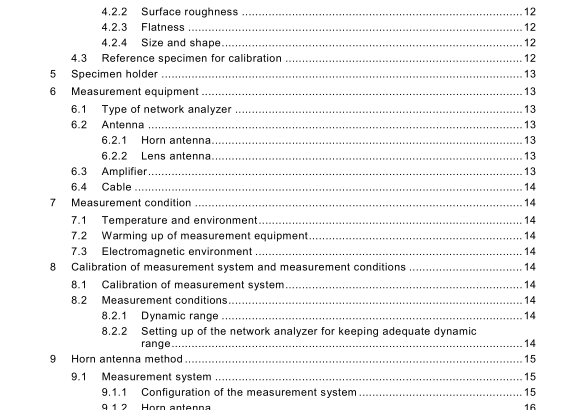IEC 62431:2008 pdf downoad – Reflectivity of electromagnetic wave absorbers in millimetre wave frequency – Measurement methods
4 Specimen
4.1 Specimen specification It is recommended that the specimen have a flat surface and rigid structure having a dimension equal to or larger than 1 0 λ l , where λ l is the wavelength of the EM wave at the lowest frequency in the measurement frequency range. However, detailed specifications are given in each type of the three measurement methods described in Clauses 9, 1 0, and 1 1 . 4.2 Reference metal plate 4.2.1 Material and thickness Aluminium, copper, stainless steel or other metal, which has thickness of about 1 mm to 2 mm, is preferred.
4.2.2 Surface roughness The surface roughness of a reference metal plate should be less than λ m /1 0, although less than λ m /20 is preferred, where λ m is the wavelength that corresponds to maximum frequency in the measurement frequencies range. For example, if the maximum frequency is 300 GHz, then λ is 1 mm, and the preferable roughness becomes 0,05 mm.
4.2.3 Flatness It is recommended that the flatness be less than 0,5 mm for a reference metal plate with size 1 m × 1 m.
4.2.4 Size and shape The reference metal plate should have the same size and same projection shape normal to the specimen surface. However, it is desirable to use the size specified by each method in Clauses 9, 1 0, and 1 1 . Care should be taken in selecting the size of the reference metal plate because the reflection and scattering characteristics may depend on its size due to the Fresnel refraction. The dependence of the reflection and scattering characteristics on the size in the case of the horn antenna method is illustrated in Annex A.
4.3 Reference specimen for calibration The reference specimen for calibration should be silica-glass plate or sapphire single crystal (001 ) plate with uniform thickness and smooth surface roughness. Relative permittivity should be known in advance. When dielectric material is selected, it is necessary to measure the reflectivity of the specimen without putting anything on the backward surface of the reference specimen. The reference specimen should be fixed by a material such as foamed plastics, which has relative permittivity near to 1 , and in which EM waves do not reflect like they do in free space. It is recommended to verify the accuracy of the measurement system by comparing the measured reflectivity with the theoretical one. The reflectivity of a silica-glass plate measured in the millimetre wave range is given in Annex B.
5 Specimen holder A specimen holder might be different by the any type of measurement method mentioned in Clauses 9, 1 0, and 1 1 . It should be recommended that the specimen holder possess functions for adjusting azimuth and elevation.
6 Measurement equipment
The equipment must be calibrated according to the procedure established by the manufacturers, or calibration laboratories accredited by ISO/IEC 1 7025. The items to be calibrated include frequency, voltage, and attenuation, which depend on the measurement accuracy or uncertainty of the measurement apparatuses. Correct usage of the measurement equipment is very important in order to obtain the exact results. The measurement of the reflectivity of EMA shall be performed using either a VNA or SNA. When there are discrepancies in the measured results, it is necessary to make calibration of the measurement system using a reference specimen. Various necessary apparatuses should be selected according to the type of used measurement methods as shown below.
6.1 Type of network analyzer
The VNA is recommended because it can measure both the magnitude and phase of S 1 1 and S 21 and it has a time domain function.
The SNA can measure only the magnitude of S 1 1 and S 21 .
6.2 Antenna
6.2.1 Horn antenna
Both a commercial as well as an in-built horn antenna can be used for the reflectivity measurement of EMA except in special cases. However, the commercial horn antenna is recommended in order to obtain the required measurement accuracy, which has an accurate gain, VSWR, and size. The commercial coaxial-waveguide transducer is also recommended where the VSWR or sizes are verified in each frequency band. The specifications of some commercial horn antennas are shown in Annex C.
